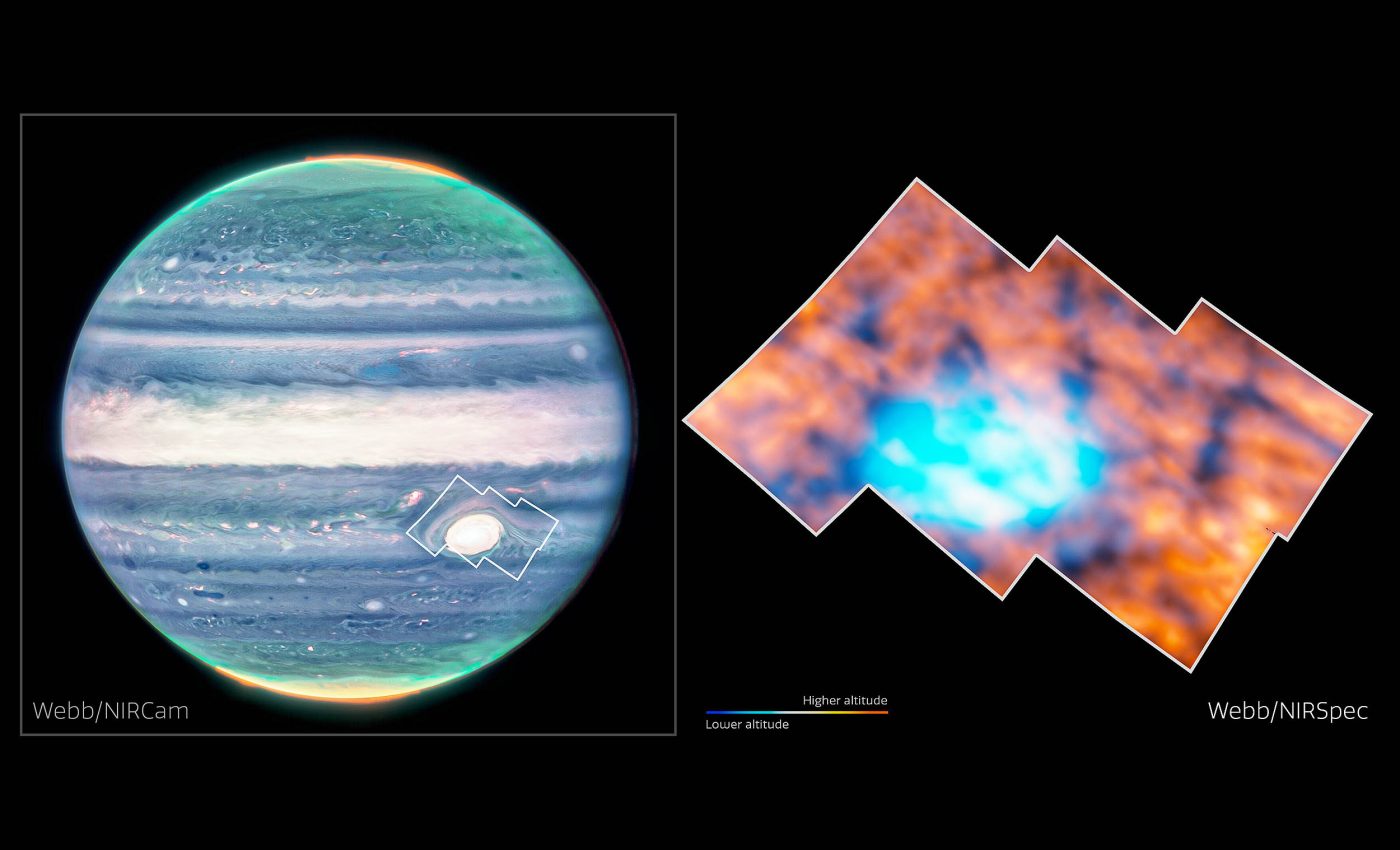
Surprising 'shapes' discovered near Jupiter’s Great Red Spot
Jupiter’s striking size, swirling gases, and dramatic bands in its atmosphere set it apart from every other planet. One of its most iconic features is the Great Red Spot, a storm so vast that it has defined the planet’s appearance for centuries.
Until now, much of the discussion has centered on the spectacle of that colossal storm itself. Recent observations are shining a new light on what happens above this famous vortex.
These details open a fresh perspective on Jupiter’s upper atmosphere, revealing unexpected structures and patterns.
These findings have been led by team leader Henrik Melin of the University of Leicester in the United Kingdom.
By focusing on the region above the Great Red Spot, researchers have broadened our understanding of ionospheric activity on the gas giant.
Fresh insights on Jupiter’s atmosphere
Astronomers used the NASA/ESA/CSA James Webb Space Telescope (JWST) to look at a portion of Jupiter once thought to be nondescript.
The instrument’s infrared capabilities allowed scientists to analyze the gas giant’s upper atmosphere, an area where sunlight plays a role but had been assumed to be uniform.
They found that Jupiter’s distance from the Sun means it receives only 4% of the sunlight hitting Earth, so it came as a surprise to see a host of intricate activity at these heights.
The team studied this region using Webb’s Near-Infrared Spectrograph (NIRSpec). After targeting the area above the Great Red Spot, they identified dark arcs and bright points, distributed across the field of view in ways never documented before.
“We thought this region, perhaps naively, would be really boring,” shared team leader Henrik Melin. “It is in fact just as interesting as the northern lights, if not more so. Jupiter never ceases to surprise.”
Wave patterns and the Great Red Spot
Although solar illumination drives the light coming from this zone, something else seems to be shaping the patterns.
“One way in which you can change this structure is by gravity waves – similar to waves crashing on a beach, creating ripples in the sand,” explained Melin.
“These waves are generated deep in the turbulent lower atmosphere, all around the Great Red Spot, and they can travel up in altitude, changing the structure and emissions of the upper atmosphere.”

The fact that Earth also experiences these phenomena is intriguing, though the effect here at home is much weaker.
The group behind these observations hopes to follow up on these wave patterns to see how they migrate through Jupiter’s upper atmosphere and affect the energy balance of that region.
By observing these shifts over time, scientists can refine their ideas about Jupiter’s atmospheric mechanics.
Jupiter’s upper atmosphere
Tom Stallard, Professor of Planetary Astronomy at Northumbria University, worked on this effort and has been studying the upper layers of gas giants for many years.
“We used to think of a planet’s aurora as the only interesting place in terms of ionospheric activity, but these new images show that is not always the case,” Stallard explained.
“Even spacecraft which have gone to Jupiter, such as the NASA Juno mission, have not had the sensitivity required to pull out this level of ionospheric detail.”
The images taken by Webb highlight features that were once simply too faint for ground-based equipment or earlier missions to spot.
Stallard continued, “In future it would be interesting to observe how the patterns we see over the Great Red Spot change, and how these waves move throughout Jupiter’s upper atmosphere.”
Why does any of this matter?
Jupiter’s magnetic field is much more intense than Earth’s, yet there are parallels in the way ionospheres behave.
“Although Jupiter appears very different to Earth there is actually much we can learn about our own planet by studying Jupiter. The processes going on are very similar, but Jupiter’s magnetic field is much stronger, and stranger,” Stallard concluded.
By investigating these processes on a bigger stage, scientists can apply fresh insights to our own world.
When features are magnified on Jupiter, it can offer straightforward ways to test models that might be more subtle in Earth’s environment.
Waiting for the Juice
These discoveries may also help guide work on ESA’s Jupiter Icy Moons Explorer, Juice, which lifted off on April 14, 2023.
That mission carries instruments designed to learn more about Jupiter and its icy satellites, specifically Ganymede, Callisto, and Europa.
The goal is to assess these worlds as potential habitats while exploring the planet’s broader surroundings.
The insights from Webb could prove vital when Juice measures the structures of Jupiter’s magnetic and atmospheric environment up close.
Researchers plan to examine Jupiter’s entire system to see how it compares to other gas giants across the universe.
By focusing on wave patterns near the planet’s equatorial belt and looking at how charged particles behave, the mission might provide further clarity on what drives the weather patterns and emissions in Jupiter’s upper layers.
Learning from Jupiter’s atmosphere
With the Webb telescope’s remarkable precision, scientists have found another layer of interest that is changing the way we think about ionospheric activities in the outer solar system.
Each new image confirms there are still stories unfolding above that swirling red storm.
The spotlight now shifts to exploring these atmospheric waves, the structures they create, and the lessons that might await our own planet.
By mapping these patterns and testing how they evolve, researchers are poised to gain a deeper understanding of giant planets both close to home and beyond.
The full study was published in the journal Nature Astronomy.
—–
Like what you read? Subscribe to our newsletter for engaging articles, exclusive content, and the latest updates.
Check us out on EarthSnap, a free app brought to you by Eric Ralls and Earth.com.
—–













